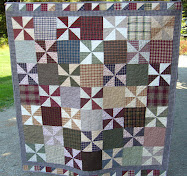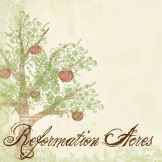Lard is a great source of fat to use in all kinds of cooking, baking and even soap making! If you raise your own pigs or even buy pigs to slaughter, you can ask the butcher to make sure that he saves you all the pig fat off your pig. There will be a lot. Depending on the size of your pig, probably about 6-8 quart jars full of lard when you're done rendering all of it.
 To make lard, you'll need a couple supplies:
To make lard, you'll need a couple supplies: Pig fat (that's a given I think)
Some source for heating it slowly. I use a crock pot but others have used their oven or stove top.
A couple bowls and jars
A strainer and some cheesecloth
Step 1: Cut up the fat. You want to clean the fat of any leftover meat or skin and cut it into apx. 1" pieces. Your pieces should be white. Depending on how good your butcher is, or isn't, you may need to trim a lot off.
You want to clean the fat of any leftover meat or skin and cut it into apx. 1" pieces. Your pieces should be white. Depending on how good your butcher is, or isn't, you may need to trim a lot off.
 Pieces, like this one above, need to be cleaned up quite a bit. You don't want to be cooking meat along with your fat.
Pieces, like this one above, need to be cleaned up quite a bit. You don't want to be cooking meat along with your fat.
Step 2: Cook the fat. I like to do mine in the crock pot on low or warm. You're going to cook it for about 12 hours, stirring occasionally. As it cooks the chunks will melt down into a liquid.
I like to do mine in the crock pot on low or warm. You're going to cook it for about 12 hours, stirring occasionally. As it cooks the chunks will melt down into a liquid.
Not everything will melt down though, in my experience. You will still be left with a little at the end that looks like this: Step 3: Strain the fat.
Step 3: Strain the fat.
You'll want to strain all the liquid off of the remaining mush through a strainer and into a bowl. Don't worry about any little bits that get into the liquid at this point, we're going to do a second straining later. If a lot of fat chunks are left you can continue to melt those down in your crock pot for another few hours.
If a lot of fat chunks are left you can continue to melt those down in your crock pot for another few hours.
I would recommend using, if you have one, a large glass bowl to place your strained liquid fat into.
Then, add 1-2c of water to your liquid fat.
Refrigerate over night.
Step 4: Skim off the lard.
Letting the liquid cool over night will allow it to separate into lard, on the top, and the water and bits of fat (that went through the strainer) on the bottom.
 You want to clean the fat of any leftover meat or skin and cut it into apx. 1" pieces. Your pieces should be white. Depending on how good your butcher is, or isn't, you may need to trim a lot off.
You want to clean the fat of any leftover meat or skin and cut it into apx. 1" pieces. Your pieces should be white. Depending on how good your butcher is, or isn't, you may need to trim a lot off. Pieces, like this one above, need to be cleaned up quite a bit. You don't want to be cooking meat along with your fat.
Pieces, like this one above, need to be cleaned up quite a bit. You don't want to be cooking meat along with your fat.Step 2: Cook the fat.
 I like to do mine in the crock pot on low or warm. You're going to cook it for about 12 hours, stirring occasionally. As it cooks the chunks will melt down into a liquid.
I like to do mine in the crock pot on low or warm. You're going to cook it for about 12 hours, stirring occasionally. As it cooks the chunks will melt down into a liquid.Not everything will melt down though, in my experience. You will still be left with a little at the end that looks like this:
 Step 3: Strain the fat.
Step 3: Strain the fat.You'll want to strain all the liquid off of the remaining mush through a strainer and into a bowl. Don't worry about any little bits that get into the liquid at this point, we're going to do a second straining later.
 If a lot of fat chunks are left you can continue to melt those down in your crock pot for another few hours.
If a lot of fat chunks are left you can continue to melt those down in your crock pot for another few hours.I would recommend using, if you have one, a large glass bowl to place your strained liquid fat into.
Then, add 1-2c of water to your liquid fat.
Refrigerate over night.
Step 4: Skim off the lard.
Letting the liquid cool over night will allow it to separate into lard, on the top, and the water and bits of fat (that went through the strainer) on the bottom.
Now it's time to scrape off the lard. I made the mistake of using a large stainless steel pot this time. Since the bottom is so wide on the pot, it makes it difficult to skim off the lard once it's cool. As you can see from the picture below, some of the leftover chunkiness had to be scraped from the lard.
I made the mistake of using a large stainless steel pot this time. Since the bottom is so wide on the pot, it makes it difficult to skim off the lard once it's cool. As you can see from the picture below, some of the leftover chunkiness had to be scraped from the lard. Step 5: Melt down the lard in a pot.
Step 5: Melt down the lard in a pot. You're going to melt down all the cooled, hardened lard in another pot till it reaches a liquid form. Then place a cheese cloth (or thin cotton dish cloth) over a strainer and pour your lard through the cloth. This will catch any of the last tiny little bits of fat and give you a nice clean lard.
You're going to melt down all the cooled, hardened lard in another pot till it reaches a liquid form. Then place a cheese cloth (or thin cotton dish cloth) over a strainer and pour your lard through the cloth. This will catch any of the last tiny little bits of fat and give you a nice clean lard. Step 6: Pour your lard into jars.
Step 6: Pour your lard into jars. Place a lid on the jars and store in your fridge. You can store it in your fridge for up to a year. If left out on a shelf, maybe for 4-6 months. You can also freeze your lard.
Place a lid on the jars and store in your fridge. You can store it in your fridge for up to a year. If left out on a shelf, maybe for 4-6 months. You can also freeze your lard.
 I made the mistake of using a large stainless steel pot this time. Since the bottom is so wide on the pot, it makes it difficult to skim off the lard once it's cool. As you can see from the picture below, some of the leftover chunkiness had to be scraped from the lard.
I made the mistake of using a large stainless steel pot this time. Since the bottom is so wide on the pot, it makes it difficult to skim off the lard once it's cool. As you can see from the picture below, some of the leftover chunkiness had to be scraped from the lard. Step 5: Melt down the lard in a pot.
Step 5: Melt down the lard in a pot. You're going to melt down all the cooled, hardened lard in another pot till it reaches a liquid form. Then place a cheese cloth (or thin cotton dish cloth) over a strainer and pour your lard through the cloth. This will catch any of the last tiny little bits of fat and give you a nice clean lard.
You're going to melt down all the cooled, hardened lard in another pot till it reaches a liquid form. Then place a cheese cloth (or thin cotton dish cloth) over a strainer and pour your lard through the cloth. This will catch any of the last tiny little bits of fat and give you a nice clean lard. Step 6: Pour your lard into jars.
Step 6: Pour your lard into jars. Place a lid on the jars and store in your fridge. You can store it in your fridge for up to a year. If left out on a shelf, maybe for 4-6 months. You can also freeze your lard.
Place a lid on the jars and store in your fridge. You can store it in your fridge for up to a year. If left out on a shelf, maybe for 4-6 months. You can also freeze your lard.
.jpg)


















































8 comments:
You did a good job explaining this...I've wanted to try this, but I learn better by seeing someone else do it. Now, to find a pig....
Whoa. I had no idea that making lard required so many steps... totally interesting.
Wow! That doesn't look appetizing...to be sure! I know that lard is useful though...thanks for taking time to show the steps for making it...I learned something new today!
The process does look at bit gross but the finished product looks great. I made a small batch from a chicken soup that I made & scraped off the cooled fat. It worked so well using a scoop for cooking eggs in.
Excellent tutorial, Heather! Thanks for sharing this. I really need to give it a try. And I recognize those bowls :-) Aren't they great?
that's just gross! ha ha
you crack me up sometimes!
I'm excited you posted about this! I've been wondering how to render lard and thought it would be much harder.
I called our local butcher and asked him if I could get pig fat from him. He called back today to let me know he has some set aside ready for me. Woot! And yes, I'm chuckling at myself for being so excited about lard...
I had been so frustrated that you cannot get lard anymore and the I cam across a gal at the farmers market that carries leaf fat for rendering. I was so excited! I only got a package as I was not sure I wanted a ton of it but after readin this I am inspired :) I will do th small batch first and then get more from her this next weekend.
Thanks for all you do this is ust the stuff I have been learning, teaching, reading and blogging about myself.
Nice to find another like minded person. Teri
Post a Comment